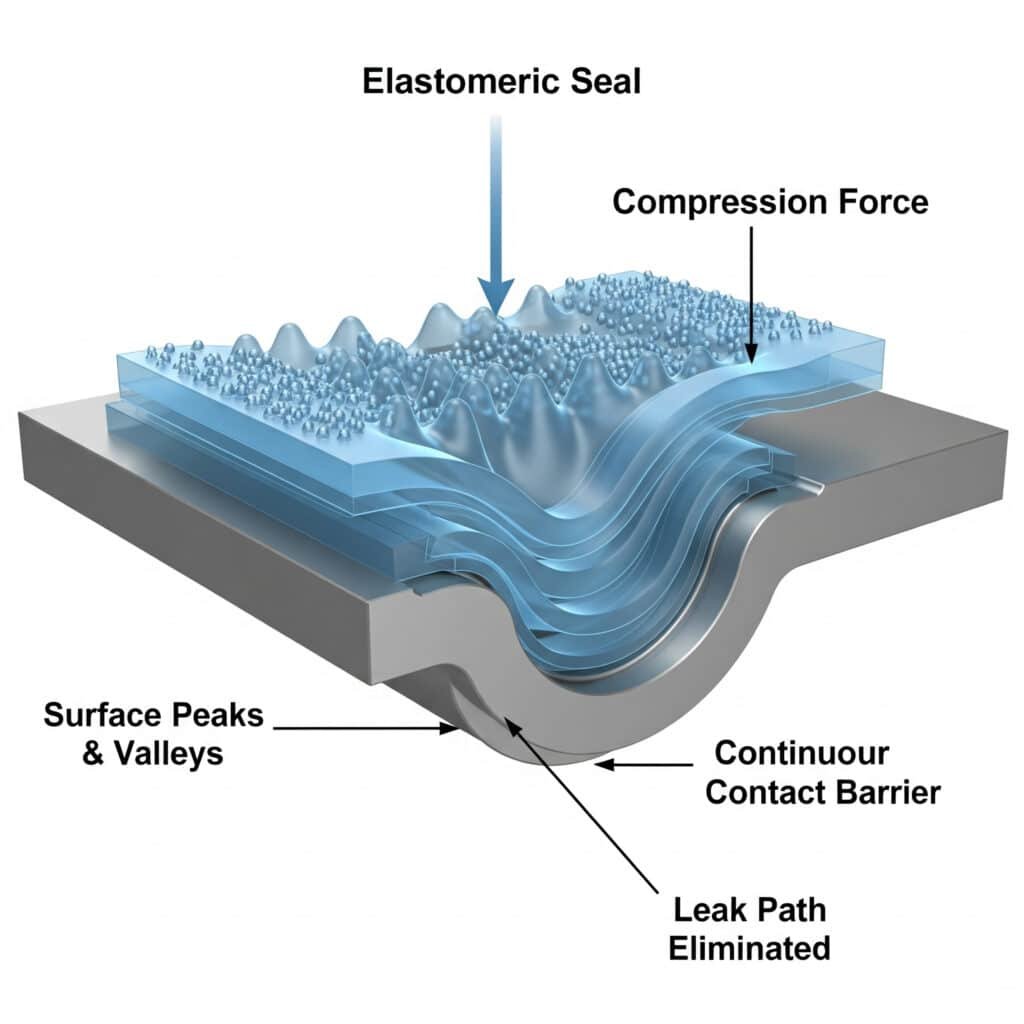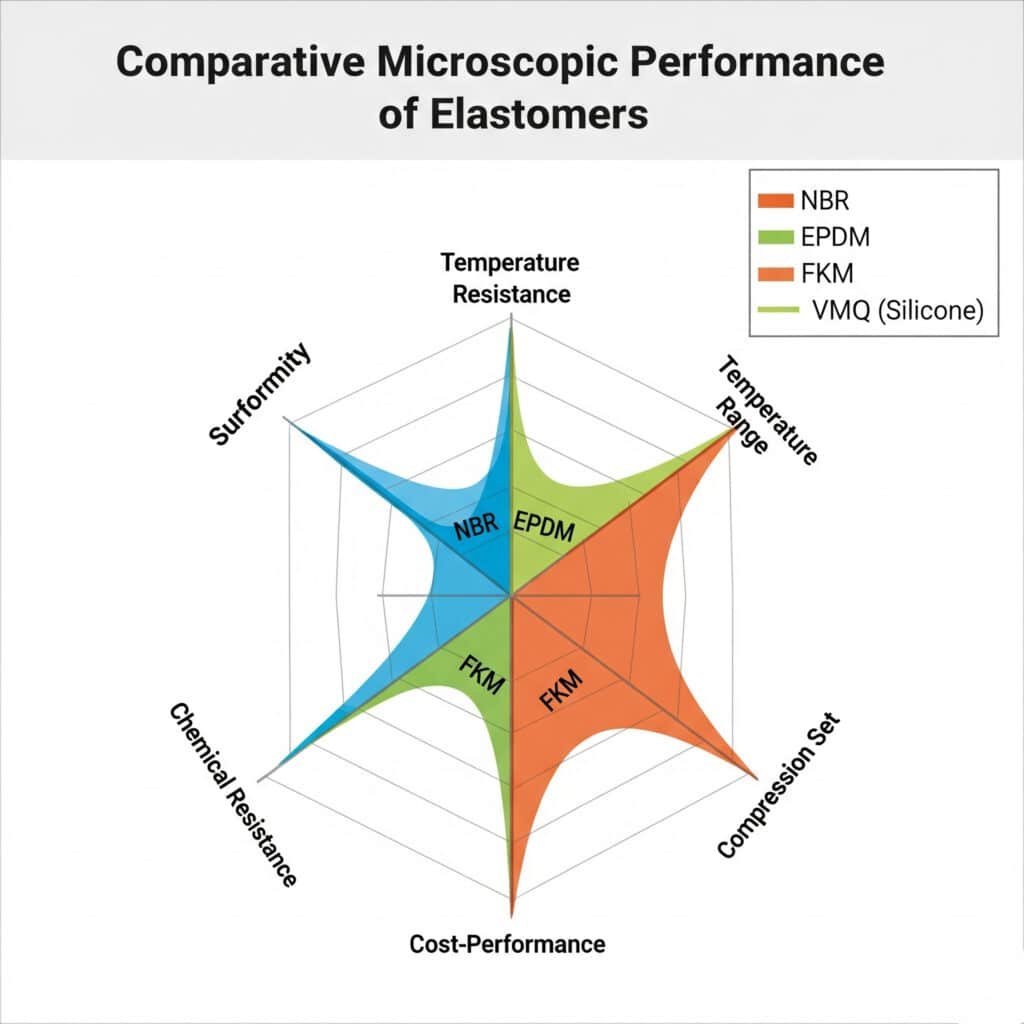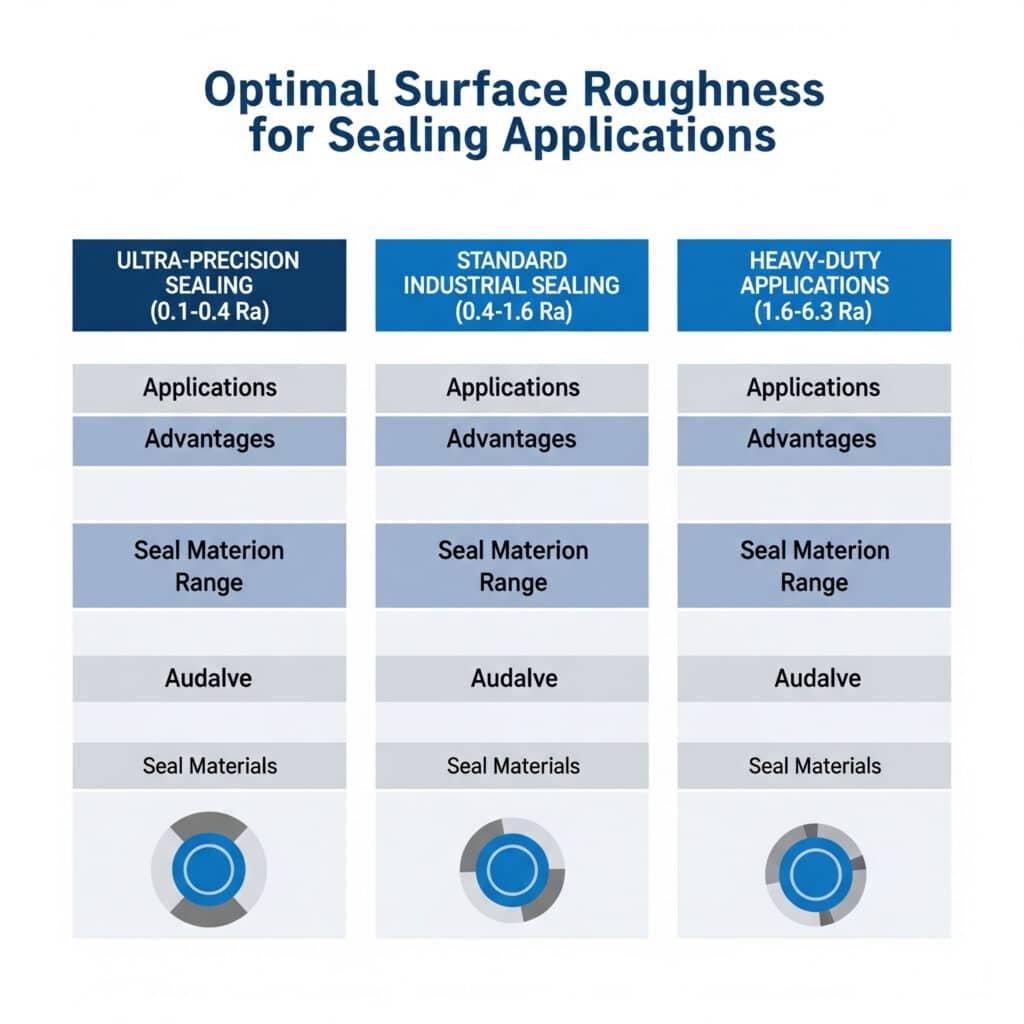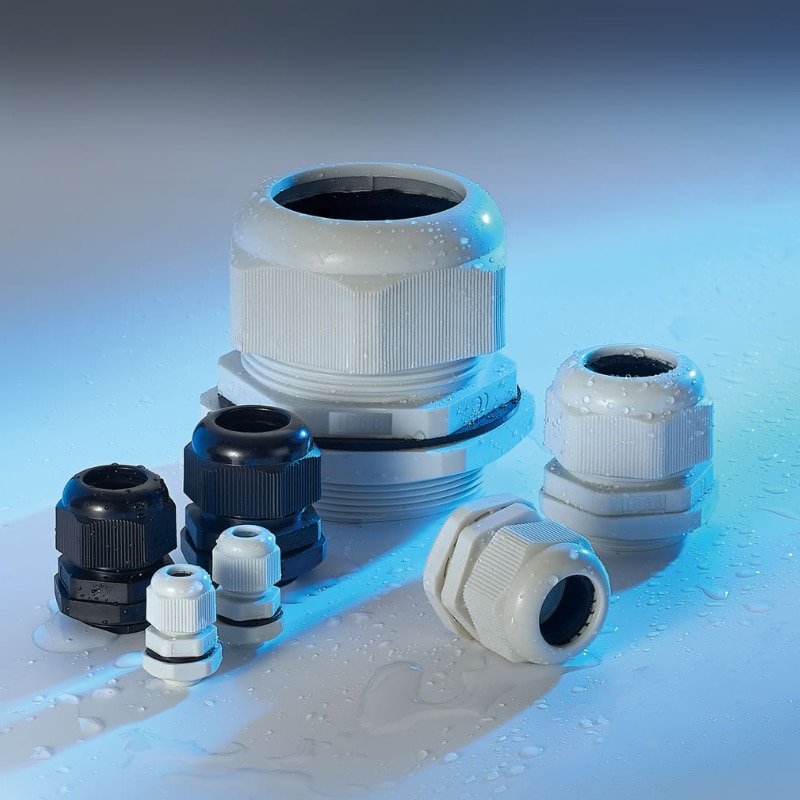Picture this: You’re staring at a seemingly perfect cable gland installation, yet somehow water finds its way inside. The mystery? What you can’t see with the naked eye – microscopic imperfections, surface roughness, and molecular-level interactions that determine whether your seal succeeds or fails spectacularly.
Cable gland sealing mechanisms work through controlled deformation of elastomeric materials1 that conform to microscopic surface irregularities, creating molecular-level contact barriers that prevent fluid penetration. The effectiveness depends on achieving optimal contact pressure, material compatibility, and surface finish quality at scales measured in micrometers.
After a decade at Bepto Connector, I’ve learned that understanding sealing at the microscopic level isn’t just academic curiosity – it’s the key to preventing those mysterious failures that drive engineers crazy. Let me take you on a journey into the invisible world where real sealing happens. 🔬
Table of Contents
- What Actually Happens When Seal Materials Contact Surfaces?
- How Do Different Elastomer Types Perform at the Molecular Level?
- What Role Does Surface Roughness Play in Sealing Effectiveness?
- How Do Environmental Factors Affect Microscopic Sealing Performance?
- What Advanced Technologies Enhance Microscopic Sealing?
- FAQ
What Actually Happens When Seal Materials Contact Surfaces?
The moment an O-ring touches a metal surface, an invisible battle begins between molecular forces, surface irregularities, and material properties. Understanding this microscopic drama is crucial for reliable sealing.
Effective sealing occurs when elastomeric materials deform to fill surface valleys and peaks at the micrometer scale, creating continuous contact barriers that block fluid penetration paths. The process involves elastic deformation, molecular adhesion, and surface conformity working together to eliminate leak paths.

The Physics of Microscopic Contact
When you compress a seal against a surface, several phenomena occur simultaneously:
Initial Contact Phase
- Asperity contact: High points on both surfaces touch first
- Elastic deformation: Seal material begins conforming to surface profile
- Load distribution: Contact pressure spreads across interface
- Air displacement: Trapped air escapes from surface valleys
Progressive Deformation
As compression increases, the seal material flows into microscopic valleys:
- Primary deformation: Large-scale shape change (visible)
- Secondary deformation: Filling of machining marks and scratches
- Tertiary deformation: Molecular-level surface conformity
- Final state: Complete elimination of leak paths
Critical Pressure Thresholds
- Minimum sealing pressure: 0.1-0.5 MPa for basic contact
- Optimal sealing pressure: 1-5 MPa for complete valley filling
- Maximum safe pressure: 10-20 MPa before seal damage
Surface Energy and Molecular Adhesion
At the microscopic level, sealing isn’t just mechanical – it’s also about molecular attraction:
Van der Waals Forces
- Range: 0.1-1.0 nanometers
- Strength: Weak but significant at molecular contact
- Effect: Enhanced adhesion between seal and surface
- Materials: Most effective with polar elastomers
Chemical Bonding
- Hydrogen bonding2: With polar surfaces and elastomers
- Dipole interactions: Between charged surface sites
- Temporary bonds: Form and break with thermal motion
- Cumulative effect: Millions of weak bonds create strong adhesion
I remember David from a precision instrument company in Germany describing his sealing challenges: “We can machine surfaces to 0.1 Ra, but still get leaks.” The issue wasn’t surface finish – it was understanding that even mirror-smooth surfaces have microscopic valleys that need filling.
Leak Path Elimination Theory
For a seal to be effective, it must eliminate ALL potential leak paths:
Continuous Barrier Formation
- Complete contact: No gaps larger than molecular dimensions
- Uniform pressure: Even distribution prevents weak spots
- Material flow: Elastomer fills every surface irregularity
- Stable interface: Maintains contact under operating conditions
Critical Leak Path Dimensions
- Water molecules: ~0.3 nanometers diameter
- Oil molecules: 1-5 nanometers typical
- Gas molecules: 0.1-0.5 nanometers
- Required seal contact: <0.1 nanometers for gas-tight sealing
How Do Different Elastomer Types Perform at the Molecular Level?
Not all seal materials are created equal at the microscopic level. Each elastomer type has unique molecular characteristics that dramatically affect sealing performance.
Different elastomer molecular structures provide varying degrees of flexibility, surface conformity, and chemical compatibility, with cross-link density and polymer chain mobility being the primary factors determining microscopic sealing effectiveness. Understanding these differences helps select optimal materials for specific applications.

Nitrile Rubber (NBR) – The Workhorse
Molecular Characteristics
- Polymer backbone: Butadiene-acrylonitrile copolymer
- Cross-link density: Moderate (good flexibility/strength balance)
- Glass transition temperature3: -40°C to -10°C depending on ACN content
- Molecular mobility: Good at room temperature
Microscopic Performance
- Surface conformity: Excellent for moderate surface roughness
- Recovery properties: Good elastic memory after deformation
- Temperature stability: Maintains sealing 20-120°C
- Chemical resistance: Good with petroleum products
Real-World Application: Hassan’s refinery in Saudi Arabia uses our NBR-sealed cable glands in crude oil service. Microscopic analysis after 5 years showed excellent surface contact maintenance despite thermal cycling.
EPDM – The Environmental Champion
Molecular Structure Advantages
- Saturated backbone: No double bonds for oxidation
- Side chain flexibility: Enhanced low-temperature performance
- Cross-link stability: Excellent aging resistance
- Polar groups: Good adhesion to metal surfaces
Microscopic Sealing Properties
- Temperature range: Maintains flexibility -50°C to +150°C
- Ozone resistance: Molecular structure prevents cracking
- Surface wetting: Good contact with various substrates
- Long-term stability: Minimal property changes over time
Fluorocarbon (FKM/Viton) – The Chemical Specialist
Unique Molecular Features
- Fluorine atoms: Create chemical inertness
- Strong C-F bonds: Resist chemical attack
- High cross-link density: Excellent mechanical properties
- Low permeability: Minimal gas/vapor transmission
Microscopic Performance Characteristics
- Surface hardness: Requires higher compression for conformity
- Chemical compatibility: Inert to most aggressive chemicals
- Temperature stability: Maintains properties up to 200°C
- Permeation resistance: Blocks molecular-level penetration
Silicone (VMQ) – The Temperature Extremist
Molecular Structure Benefits
- Si-O backbone: Extremely flexible at low temperatures
- Organic side groups: Provide chemical compatibility options
- Low glass transition: Remains flexible to -100°C
- Thermal stability: Maintains properties to 250°C
Microscopic Sealing Behavior
- Exceptional conformity: Flows into finest surface details
- Temperature independence: Consistent sealing across wide range
- Low compression set: Maintains contact pressure over time
- Surface energy: Good wetting on most substrates
Comparative Microscopic Performance
| Property | NBR | EPDM | FKM | VMQ |
|---|---|---|---|---|
| Surface Conformity | Good | Excellent | Fair | Excellent |
| Temperature Range | Moderate | Good | Excellent | Excellent |
| Chemical Resistance | Moderate | Good | Excellent | Fair |
| Compression Set | Good | Excellent | Good | Fair |
| Cost-Performance | Excellent | Good | Fair | Poor |
Material Selection for Microscopic Optimization
High Surface Roughness Applications
- First choice: EPDM or Silicone for maximum conformity
- Avoid: Hard FKM compounds that can’t flow into valleys
- Compression: Increase by 15-20% for rough surfaces
Precision Applications (Ra < 0.4)
- Optimal: NBR or FKM for dimensional stability
- Benefits: Lower compression requirements
- Considerations: Surface preparation critical for performance
Chemical Service
- Aggressive chemicals: FKM mandatory despite conformity limitations
- Mild chemicals: EPDM provides better sealing with adequate resistance
- Compatibility testing: Essential for long-term reliability
Marcus from that Manchester project learned this lesson when switching from NBR to EPDM seals improved his IP68 test results from 85% pass rate to 99% – simply because EPDM conformed better to his machined surfaces at the microscopic level.
What Role Does Surface Roughness Play in Sealing Effectiveness?
Surface roughness isn’t just a manufacturing specification – it’s the microscopic landscape that determines whether your seals succeed or fail. Understanding this relationship is crucial for reliable gland performance.
Surface roughness4 directly affects sealing pressure requirements and leak path formation, with optimal roughness values of 0.4-1.6 Ra providing the best balance between seal conformity and manufacturing cost. Too smooth surfaces can actually reduce sealing effectiveness due to insufficient mechanical keying.

The Roughness-Sealing Relationship
Surface Roughness Measurement
- Ra (Average roughness): Most common specification
- Rz (Peak-to-valley height): Critical for deep scratches
- Rmax (Maximum peak height): Determines pressure requirements
- Bearing ratio: Percentage of surface in contact
Optimal Roughness Ranges by Application
Ultra-Precision Sealing (0.1-0.4 Ra)
- Applications: Hydraulic systems, precision instruments
- Advantages: Low sealing pressure requirements
- Disadvantages: Expensive machining, limited mechanical keying
- Seal materials: Hard compounds (Shore A 80-90)
Standard Industrial Sealing (0.4-1.6 Ra)
- Applications: Most cable gland installations
- Advantages: Good conformity/cost balance
- Disadvantages: Moderate pressure requirements
- Seal materials: Medium compounds (Shore A 60-80)
Heavy-Duty Applications (1.6-6.3 Ra)
- Applications: Large glands, cast housings
- Advantages: Excellent mechanical keying
- Disadvantages: High sealing pressure needed
- Seal materials: Soft compounds (Shore A 40-70)
Microscopic Seal-Surface Interaction
Valley Filling Mechanics
When a seal contacts a rough surface, material flow follows predictable patterns:
- Initial contact: High peaks compress first
- Progressive filling: Material flows into valleys
- Complete sealing: All valleys filled to critical depth
- Pressure equilibrium: Uniform contact established
Critical Valley Depth
- Shallow valleys (<5 μm): Easy to fill with moderate pressure
- Medium valleys (5-25 μm): Require optimal material selection
- Deep valleys (>25 μm): May require multiple seal elements
Surface Directionality Effects
- Circumferential finish: Ideal for O-ring applications
- Axial finish: Can create spiral leak paths
- Cross-hatch pattern: Provides excellent seal retention
- Random finish: Good general-purpose performance
Manufacturing Process Impact
Machining Effects on Sealing
Different manufacturing processes create unique microscopic signatures:
CNC Machining
- Surface quality: Excellent repeatability
- Roughness control: Precise Ra achievement
- Directionality: Controllable tool path patterns
- Cost: Higher but justified for critical applications
Casting Processes
- Surface variation: Higher roughness, less predictable
- Porosity concerns: Microscopic voids can create leak paths
- Finishing requirements: Often need secondary machining
- Seal selection: Require softer, more conformable materials
Molding/Forming
- Surface replication: Copies mold surface exactly
- Consistency: Excellent part-to-part uniformity
- Limitations: Draft angles affect seal groove geometry
- Applications: High-volume production advantages
Real-World Surface Roughness Case Studies
David’s Precision Instrument Challenge
Problem: 0.1 Ra surfaces with hard NBR seals showing 15% leak rate
Root cause: Insufficient mechanical keying between seal and surface
Solution: Switch to 0.8 Ra finish with softer EPDM compound
Result: <1% leak rate with improved long-term stability
Hassan’s Petrochemical Application
Challenge: Cast aluminum housings with 6.3 Ra roughness
Issue: Standard seals couldn’t fill deep valleys completely
Solution: Two-stage sealing with soft primary seal plus backup O-ring
Outcome: Achieved IP68 rating with 99.5% reliability
Surface Preparation Best Practices
Cleaning Requirements
- Degreasing: Remove all machining oils and contaminants
- Particle removal: Eliminate abrasive debris from valleys
- Drying: Ensure complete moisture removal
- Inspection: Verify cleanliness before seal installation
Quality Control Measures
- Roughness verification: Measure actual vs. specified Ra
- Visual inspection: Check for scratches, gouges, or defects
- Contamination testing: Verify cleanliness levels
- Documentation: Record surface condition for traceability
At Bepto, we specify surface roughness requirements for all our cable gland mating surfaces and provide detailed preparation instructions. This attention to microscopic details is why our customers achieve >99% sealing success rates in critical applications.
How Do Environmental Factors Affect Microscopic Sealing Performance?
Environmental conditions don’t just affect the bulk properties of sealing materials – they dramatically alter microscopic interactions between seals and surfaces. Understanding these effects is crucial for long-term reliability.
Temperature, pressure, chemical exposure, and time all affect molecular mobility, surface adhesion, and material properties at the microscopic level, requiring environmental compensation in material selection and design parameters. These factors can increase leak rates by 10-1000x if not properly addressed.
Temperature Effects on Microscopic Sealing
Low Temperature Impacts
Molecular Level Changes:
- Reduced chain mobility: Polymer chains become rigid
- Increased glass transition effects: Material becomes glassy
- Surface conformity loss: Reduced ability to fill valleys
- Thermal contraction: Creates gaps at seal interfaces
Critical Temperature Thresholds:
- NBR: Sealing effectiveness drops below -20°C
- EPDM: Maintains performance to -40°C
- FKM: Limited to -15°C for dynamic sealing
- VMQ: Effective sealing maintained to -60°C
Microscopic Compensation Strategies:
- Softer compounds: Lower durometer maintains flexibility
- Increased compression: 25-50% higher squeeze ratios
- Surface finish optimization: Smoother surfaces (0.2-0.4 Ra)
- Preload mechanisms: Spring-loaded seal retention
High Temperature Effects
Molecular Degradation Processes:
- Cross-link breakdown: Reduced elastic properties
- Chain scission: Permanent deformation increases
- Oxidation reactions: Surface hardening occurs
- Volatile loss: Plasticizers evaporate, seals shrink
Performance Degradation Timeline:
- 0-1000 hours: Minimal property changes
- 1000-5000 hours: Noticeable compression set increase
- 5000-10000 hours: Significant sealing pressure loss
- >10000 hours: Replacement typically required
Sarah from a geothermal facility in Iceland shared her experience: “We thought our cable glands were failing due to vibration, but microscopic analysis showed the EPDM seals were losing molecular flexibility at 180°C, creating micro-gaps we couldn’t see.”
Pressure Effects on Seal Interfaces
High Pressure Applications
Microscopic Phenomena:
- Enhanced conformity: Increased surface contact area
- Material flow: Seal extrusion into clearance gaps
- Stress concentration: Localized high-pressure points
- Permanent deformation: Compression set acceleration
Pressure Optimization Guidelines:
- 5-15 MPa: Optimal sealing pressure range
- 15-30 MPa: Acceptable with proper groove design
- >30 MPa: Risk of seal damage and extrusion
- Backup rings: Required above 20 MPa pressure
Vacuum Applications
Unique Challenges:
- Outgassing: Volatile compounds create contamination
- Surface adhesion: Enhanced molecular contact needed
- Permeation: Gas molecules pass through seal material
- Compression requirements: Higher squeeze ratios necessary
Chemical Environment Microscopic Effects
Swelling and Shrinkage
Molecular Mechanisms:
- Solvent absorption: Polymer chains separate, seals swell
- Plasticizer extraction: Material shrinks and hardens
- Chemical reaction: Cross-links break or form
- Surface degradation: Microscopic cracking develops
Compatibility Assessment Methods:
- Volume swell testing: ASTM D471 standard protocol
- Compression set evaluation: Long-term deformation measurement
- Surface analysis: Microscopic examination for degradation
- Permeation testing: Molecular transmission rates
Aggressive Chemical Effects
Fluorinated Compounds:
- Molecular attack: Break polymer backbone bonds
- Surface etching: Create microscopic leak paths
- Rapid degradation: Failure within hours or days
- Material selection: Only FKM provides adequate resistance
Oxidizing Agents:
- Free radical formation: Accelerated aging reactions
- Cross-link changes: Alter mechanical properties
- Surface hardening: Reduced conformity capability
- Antioxidant depletion: Progressive performance loss
Time-Dependent Microscopic Changes
Compression Set Development
Molecular Relaxation Process:
- Initial deformation: Elastic response dominates
- Stress relaxation: Polymer chains rearrange
- Permanent set: Irreversible molecular changes
- Sealing loss: Reduced contact pressure over time
Predictive Modeling:
- Arrhenius equations5: Temperature acceleration factors
- Williams-Landel-Ferry: Time-temperature superposition
- Power law relationships: Stress-time correlations
- Service life prediction: Based on acceptable performance limits
Environmental Stress Cracking
Microscopic Crack Initiation:
- Stress concentration: At surface imperfections
- Environmental attack: Chemical weakening of bonds
- Crack propagation: Progressive failure development
- Catastrophic failure: Sudden sealing loss
Marcus discovered this phenomenon when his outdoor cable glands started failing after exactly 18 months. Microscopic analysis revealed ozone-induced cracking in NBR seals that wasn’t visible until failure occurred. Switching to EPDM eliminated the problem completely.
Environmental Compensation Strategies
Material Selection Matrix
| Environment | Primary Choice | Secondary Option | Avoid |
|---|---|---|---|
| High Temperature | FKM | EPDM | NBR |
| Low Temperature | VMQ | EPDM | FKM |
| Chemical Service | FKM | EPDM | NBR |
| Outdoor/Ozone | EPDM | VMQ | NBR |
| High Pressure | NBR | FKM | VMQ |
| Vacuum Service | FKM | EPDM | NBR |
Design Modifications
- Groove geometry: Optimize for environmental conditions
- Compression ratios: Adjust for temperature effects
- Surface finishes: Compensate for material property changes
- Backup systems: Redundant sealing for critical applications
What Advanced Technologies Enhance Microscopic Sealing?
Modern sealing technology goes far beyond traditional O-rings and gaskets. Advanced materials and manufacturing techniques are revolutionizing microscopic sealing performance.
Nanotechnology, surface treatments, and advanced polymer chemistry enable sealing performance improvements of 10-100x over conventional approaches through molecular-level engineering of seal-surface interfaces. These technologies are becoming mainstream in critical applications.
Nanotechnology Applications
Nanoparticle Reinforcement
Carbon Nanotube Integration:
- Molecular structure: Single-wall and multi-wall tubes
- Property enhancement: 100x strength increase possible
- Thermal conductivity: Improved heat dissipation
- Electrical properties: Controlled conductivity for EMC applications
Graphene Incorporation:
- Two-dimensional structure: Ultimate thinness with strength
- Barrier properties: Impermeable to gas molecules
- Flexibility maintenance: Doesn’t compromise elasticity
- Chemical inertness: Enhanced chemical resistance
Nano-Surface Modifications
Plasma Treatment:
- Surface activation: Increases adhesion energy
- Molecular bonding: Creates chemical attachment points
- Controlled roughness: Nanometer-scale texture optimization
- Contamination removal: Molecular-level cleaning
Self-Assembled Monolayers (SAMs):
- Molecular organization: Ordered surface structures
- Tailored properties: Hydrophobic/hydrophilic control
- Chemical functionality: Specific molecular interactions
- Thickness control: Angstrom-level precision
Advanced Polymer Chemistry
Shape Memory Polymers
Molecular Mechanism:
- Temporary shape: Deformed state at installation
- Trigger activation: Temperature or chemical stimulus
- Shape recovery: Returns to optimized sealing geometry
- Enhanced contact: Automatic pressure adjustment
Applications in Cable Glands:
- Installation ease: Compress for insertion, expand for sealing
- Self-healing: Automatic gap closure after thermal cycling
- Adaptive sealing: Responds to environmental changes
- Maintenance reduction: Self-optimizing performance
Liquid Crystal Elastomers
Unique Properties:
- Molecular orientation: Aligned polymer chains
- Anisotropic behavior: Direction-dependent properties
- Stimuli response: Changes with temperature/electric field
- Reversible deformation: Controlled shape changes
Sealing Advantages:
- Directional sealing: Optimized for specific leak paths
- Active adjustment: Real-time sealing pressure control
- Environmental adaptation: Automatic property optimization
- Extended service life: Reduced degradation mechanisms
Smart Sealing Systems
Embedded Sensors
Microscopic Monitoring:
- Pressure sensors: Real-time contact pressure measurement
- Temperature monitoring: Local thermal condition tracking
- Chemical detection: Degradation product identification
- Strain measurement: Seal deformation quantification
Data Integration:
- Wireless transmission: Remote monitoring capability
- Predictive analytics: Failure prediction algorithms
- Maintenance scheduling: Optimized replacement timing
- Performance optimization: Real-time parameter adjustment
Self-Healing Materials
Molecular Repair Mechanisms:
- Microcapsule systems: Healing agent release upon damage
- Reversible bonding: Temporary cross-links that reform
- Shape memory recovery: Automatic crack closure
- Catalytic repair: Chemical reactions restore properties
Implementation in Sealing:
- Micro-crack healing: Prevents leak path development
- Extended service life: 2-5x conventional seal lifetime
- Reduced maintenance: Self-repairing capabilities
- Improved reliability: Automatic performance restoration
Surface Engineering Technologies
Atomic Layer Deposition (ALD)
Process Capabilities:
- Atomic precision: Single-layer thickness control
- Conformal coating: Uniform coverage on complex geometries
- Chemical tailoring: Specific molecular functionality
- Defect-free films: Pinhole-free barrier layers
Sealing Applications:
- Barrier enhancement: Molecular-level impermeability
- Chemical protection: Inert surface layers
- Adhesion promotion: Optimized seal-surface bonding
- Wear resistance: Extended surface durability
Laser Surface Texturing
Microscopic Pattern Creation:
- Controlled roughness: Precise valley and peak dimensions
- Pattern optimization: Designed for specific seal types
- Lubrication pockets: Microscopic fluid reservoirs
- Directional properties: Anisotropic sealing characteristics
Performance Benefits:
- Reduced friction: Lower installation forces
- Enhanced retention: Mechanical seal locking
- Improved conformity: Optimized contact pressure distribution
- Extended life: Reduced wear and degradation
Real-World Advanced Technology Implementation
Hassan’s Extreme Environment Challenge
Application: Sour gas processing at 200°C, 50 bar pressure
Traditional approach: Monthly seal replacements, 15% failure rate
Advanced solution:
- Graphene-reinforced FKM seals
- Plasma-treated mating surfaces
- Embedded pressure monitoring
Results: 18-month service intervals, <1% failure rate
David’s Precision Application
Requirement: Helium-tight sealing for analytical instruments
Challenge: Conventional seals allowed molecular-level leakage
Innovation:
- ALD barrier coatings on seal surfaces
- Nano-textured mating surfaces
- Self-healing polymer matrix
Achievement: 100x improvement in leak tightness
Future Technology Trends
Biomimetic Sealing
Nature-Inspired Designs:
- Gecko adhesion: Van der Waals force utilization
- Mussel proteins: Underwater adhesion mechanisms
- Plant cuticles: Multi-layer barrier systems
- Insect joints: Flexible, durable sealing interfaces
Artificial Intelligence Integration
Smart Seal Systems:
- Machine learning: Pattern recognition for failure prediction
- Adaptive control: Real-time parameter optimization
- Predictive maintenance: AI-driven replacement scheduling
- Performance optimization: Continuous improvement algorithms
At Bepto Connector, we’re actively incorporating these advanced technologies into our next-generation cable gland designs. While traditional sealing principles remain important, these innovations are enabling performance levels that seemed impossible just a few years ago. 🚀
Conclusion
Understanding sealing at the microscopic level transforms cable gland installation from guesswork to precision engineering. The invisible world of molecular interactions, surface conformity, and environmental effects determines whether your installations succeed or fail – often in ways that aren’t apparent until it’s too late.
The key insights from our microscopic journey: surface roughness isn’t just a specification number, material selection affects performance at the molecular level, environmental factors create invisible degradation processes, and advanced technologies are revolutionizing what’s possible in sealing performance.
Whether you’re dealing with David’s precision requirements, Hassan’s extreme environments, or Marcus’s reliability challenges, the principles remain the same – control the microscopic interface, and you control the sealing performance.
At Bepto Connector, we apply this microscopic understanding to every cable gland design and manufacturing process. Our commitment to sealing science at the molecular level is why our customers achieve >99% reliability in applications where others struggle to reach 90%. The difference is in the details you can’t see. 😉
FAQ
Q: Why do some cable glands leak even when they look perfectly installed?
A: Microscopic leak paths invisible to the naked eye are the primary cause. Surface roughness, inadequate seal compression, or molecular-level gaps can allow fluid penetration even when the installation appears perfect visually.
Q: How small are the gaps that cause sealing failures?
A: Critical leak paths can be as small as 0.1-1.0 micrometers – about 100 times smaller than the width of human hair. Water molecules are only 0.3 nanometers, so even microscopic imperfections can cause failures.
Q: What surface roughness is best for cable gland sealing?
A: Optimal surface roughness is typically 0.4-1.6 Ra for most applications. Too smooth (<0.2 Ra) reduces mechanical keying, while too rough (>3.2 Ra) requires excessive compression force and may damage seals.
Q: How do I know if my seal material is compatible at the molecular level?
A: Compatibility testing should include volume swell measurements, compression set evaluation, and microscopic surface analysis after chemical exposure. Simple immersion tests don’t reveal molecular-level degradation mechanisms.
Q: Can nanotechnology really improve cable gland sealing performance?
A: Yes, significantly. Nanoparticle reinforcement can improve seal properties by 10-100x, while nano-surface treatments enhance adhesion and barrier properties. These technologies are becoming mainstream in critical applications.
-
Learn about the properties of elastomers, a class of polymers with viscosity and elasticity, commonly known as rubber. ↩
-
Explore this special type of dipole-dipole attraction between molecules, which plays a critical role in surface adhesion. ↩
-
Discover the science behind the glass transition temperature (Tg), the point at which a polymer changes from a rigid to a more flexible state. ↩
-
Understand the key parameters like Ra and Rz used to measure and specify the texture of a surface. ↩
-
Learn how this formula describes the relationship between temperature and the rate of chemical reactions, used to predict material aging. ↩



